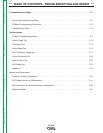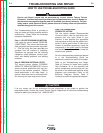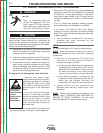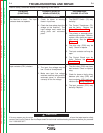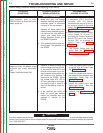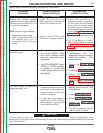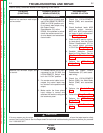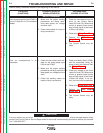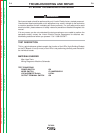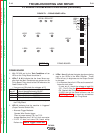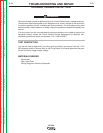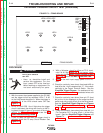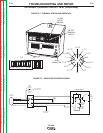
OUTPUT PROBLEMS
Observe Safety Guidelines detailed in the beginning of this manual.
PROBLEMS
(SYMPTOMS)
POSSIBLE AREAS OF
MISADJUSTMENT(S)
RECOMMENDED
COURSE OF ACTION
If for any reason you do not understand the test procedures or are unable to perform the tests/repairs safely,
contact the Lincoln Electric Service Department for technical troubleshooting assistance before you proceed.
Call 1-888-935-3877.
CAUTION
Poor arc starting when the DC600 is
in the CV Sub-Arc or CV Innershield
Modes.
1. Make sure the proper welding
procedures are being used.
(wire feed speed, arc voltage
and wire size)
2. Check weld cables for loose or
faulty connections.
1. Check the connections from the
shunt to the Control Board
(leads 210 and 215).When weld
current is present there should
be a millivolt signal at the board
(6.25mv/100 amps).
2. Perform the Firing Board Test.
3. Perform the SCR Output
Bridge Test.
4. The Control Board may be
faulty.
Poor arc characteristics in all
processes.
1. Check for the correct input volt-
ages on the three phase input
lines at the DC600.
2. Make sure the proper welding
procedures are being used (wire
feed speed, arc voltage and wire
size).
3. Check the welding cables for
loose or faulty connections.
1. Check the Mode Switch (SW4)
and the associated wiring for
loose or faulty connections. See
the Wiring Diagram.
2. Check the voltage at the shunt
(leads 210 and 215).When weld
current is present there should
be a millivolt signal at the board
(6.25mv/100 amps). If not cor-
rect, the shunt may be defective
3. Perform the Firing Board Test.
4. Perform the SCR Output
Bridge test.
5. The Control Board may be
faulty.
TROUBLESHOOTING AND REPAIR
F-8 F-8
DC-600
Return to Section TOC Return to Section TOC Return to Section TOC Return to Section TOC
Return to Master TOC Return to Master TOC Return to Master TOC Return to Master TOC




